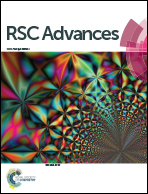Ferroelectric domain structure evolution in Ba(Zr0.1Ti0.9)O3/(Ba0.75Ca0.25)TiO3 heterostructures†
Abstract
Highly oriented multilayerd Ba(Zr0.1Ti0.9)O3/(Ba0.75Ca0.25)TiO3 thin films were fabricated on Nb doped (001) SrTiO3 (Nb:STO) substrates by pulsed laser deposition. Microstructural characterization by X-ray diffraction indicates that the as-deposited multilayered thin films are highly c-axis oriented. Transmission electron microscopy shows that the films present epitaxial correspondence with the substrate at the first layer and multi-oriented twin domain structures near the surface, especially with increasing periodic number (N). Piezoresponse force microscopy (PFM) studies reveal an intense polarization component in the out-of-plane direction, which increases greatly with increasing periodic number (N), whereas the in-plane shows inferior phase contrast. The optimized combination was found to be the annealed 16 layer structure (N = 8, layer thickness = 712 nm) which displays the best polarization domain structures and the saturated piezo response loop. The annealing process benefits the 180° domains with the same angle in the growth direction, which brings more piezo response in the in-plane signal. Our results suggest that the increasing of piezo response is greatly associated with the interface effect and the twining structure.


 Please wait while we load your content...
Please wait while we load your content...